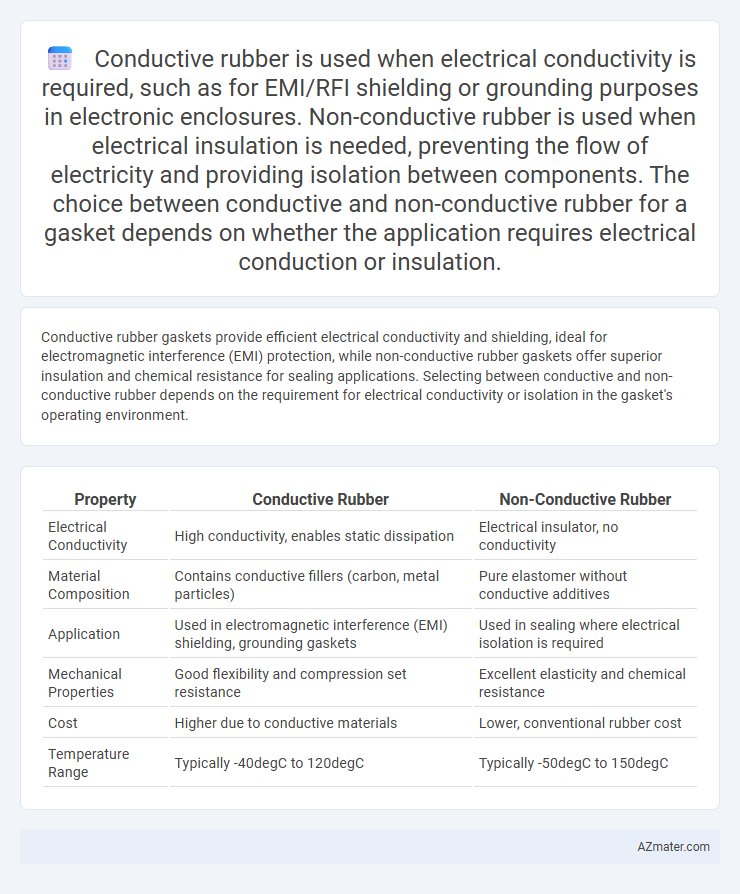Conductive rubber gaskets provide efficient electrical conductivity and shielding, ideal for electromagnetic interference (EMI) protection, while non-conductive rubber gaskets offer superior insulation and chemical resistance for sealing applications. Selecting between conductive and non-conductive rubber depends on the requirement for electrical conductivity or isolation in the gasket's operating environment.
Table of Comparison
| Property | Conductive Rubber | Non-Conductive Rubber |
|---|---|---|
| Electrical Conductivity | High conductivity, enables static dissipation | Electrical insulator, no conductivity |
| Material Composition | Contains conductive fillers (carbon, metal particles) | Pure elastomer without conductive additives |
| Application | Used in electromagnetic interference (EMI) shielding, grounding gaskets | Used in sealing where electrical isolation is required |
| Mechanical Properties | Good flexibility and compression set resistance | Excellent elasticity and chemical resistance |
| Cost | Higher due to conductive materials | Lower, conventional rubber cost |
| Temperature Range | Typically -40degC to 120degC | Typically -50degC to 150degC |
Introduction to Conductive and Non-conductive Rubber Gaskets
Conductive rubber gaskets feature embedded conductive fillers such as carbon or metal particles, enabling them to provide excellent electromagnetic interference (EMI) shielding and static dissipation in electronic and industrial applications. Non-conductive rubber gaskets, made from materials like silicone or neoprene without conductive additives, primarily offer sealing, cushioning, and insulation properties without electrical conductivity. Understanding the distinct material compositions and performance characteristics of conductive versus non-conductive rubber gaskets is essential for selecting the right gasket based on application-specific requirements like electrical conductivity, environmental sealing, and mechanical durability.
Material Composition and Properties
Conductive rubber gaskets are typically composed of silicone or EPDM infused with conductive fillers like carbon black, metal particles, or graphite, enhancing their electrical conductivity and EMI shielding capabilities. Non-conductive rubber gaskets, made from pure silicone, neoprene, or EPDM without conductive additives, provide superior insulation, chemical resistance, and weatherproofing but lack electrical conductivity. The choice between conductive and non-conductive rubber gaskets depends on requirements for electrical grounding, shielding, or isolation in industrial sealing applications.
Electrical Conductivity Comparison
Conductive rubber gaskets are embedded with conductive fillers like carbon or metal particles, enabling efficient electrical conductivity for grounding and EMI shielding in electronic devices. Non-conductive rubber gaskets lack these fillers, providing excellent insulation but no electrical conductivity, making them suitable for sealing without interference in electrical circuits. The choice depends on the application's need for conductivity, with conductive rubber gaskets ensuring reliable electrical pathways and non-conductive versions prioritizing isolation.
Applications in Electronic and Industrial Settings
Conductive rubber gaskets excel in electronic and industrial applications requiring electromagnetic interference (EMI) shielding and static dissipation, ensuring device protection and signal integrity. Non-conductive rubber gaskets provide superior sealing, chemical resistance, and insulation, ideal for environments where electrical conductivity is detrimental or unnecessary. Selecting between conductive and non-conductive rubber hinges on application-specific needs like electrical conductivity, environmental exposure, and mechanical durability.
Performance in EMI/RFI Shielding
Conductive rubber gaskets provide superior performance in EMI/RFI shielding due to their embedded conductive fillers, such as silver, nickel, or carbon, which create effective electrical continuity and attenuation of electromagnetic interference. Non-conductive rubber gaskets lack these conductive elements, resulting in limited or no EMI/RFI shielding capabilities, making them unsuitable for applications requiring electromagnetic compatibility. The choice of conductive rubber ensures enhanced shielding effectiveness, durability in harsh environments, and compliance with stringent electromagnetic interference standards.
Durability and Environmental Resistance
Conductive rubber gaskets offer superior durability with enhanced resistance to wear, ozone, and UV exposure, making them ideal for harsh environmental conditions where electrical conductivity is required. Non-conductive rubber gaskets typically provide excellent chemical resistance and flexibility but may degrade faster under extreme temperatures and prolonged UV exposure. Selecting the appropriate rubber type depends on the specific application's need for electrical conductivity balanced against environmental durability.
Cost Differences and Economic Considerations
Conductive rubber gaskets generally cost more than non-conductive rubber gaskets due to the specialized materials, such as carbon or metal fillers, used to enable electrical conductivity. Non-conductive rubber gaskets, made from standard elastomers like silicone or EPDM, are typically more affordable and suitable for applications with no electrical requirements. Evaluating the total cost of ownership involves balancing the higher upfront material cost of conductive rubber against the potential benefits of improved grounding, EMI shielding, or static dissipation in sensitive electronic or industrial environments.
Installation and Maintenance Requirements
Conductive rubber gaskets require careful installation to ensure proper electrical grounding and avoid performance issues, often needing precise torque specifications and clean contact surfaces. Non-conductive rubber gaskets offer easier installation with more tolerance for surface irregularities, reducing the risk of damage during fitting. Maintenance of conductive rubber gaskets involves regular inspections for electrical continuity and surface contamination, whereas non-conductive types primarily focus on physical integrity and sealing effectiveness.
Advantages and Disadvantages of Each Type
Conductive rubber gaskets offer excellent electrical conductivity and EMI shielding, making them ideal for electronic enclosures and grounding applications, but they tend to be more expensive and less resistant to harsh chemicals. Non-conductive rubber gaskets provide superior insulation, better chemical resistance, and cost-effectiveness, suitable for sealing and cushioning without electrical interference concerns. Choosing between the two depends on the specific application requirements for conductivity, environmental resistance, and budget constraints.
Choosing the Right Rubber Gasket for Your Application
Conductive rubber gaskets, infused with carbon or metal particles, provide excellent electrical conductivity, making them ideal for applications requiring electromagnetic interference (EMI) shielding or static discharge prevention. Non-conductive rubber gaskets, often made from materials like neoprene, silicone, or EPDM, offer superior chemical resistance, sealing performance, and insulation in general-purpose applications without electrical conductivity. Selecting the right rubber gasket depends on whether your application demands electrical conductivity for protection against EMI/static or prioritizes chemical resistance and sealing integrity in non-electrical environments.

Infographic: Conductive rubber vs Non-conductive rubber for Gasket
 azmater.com
azmater.com